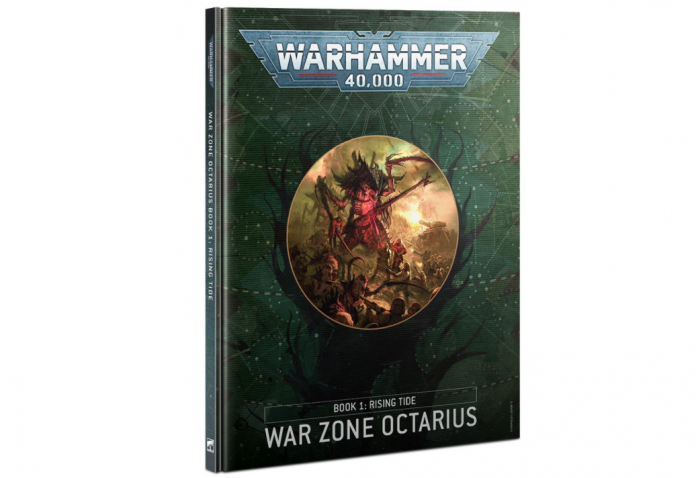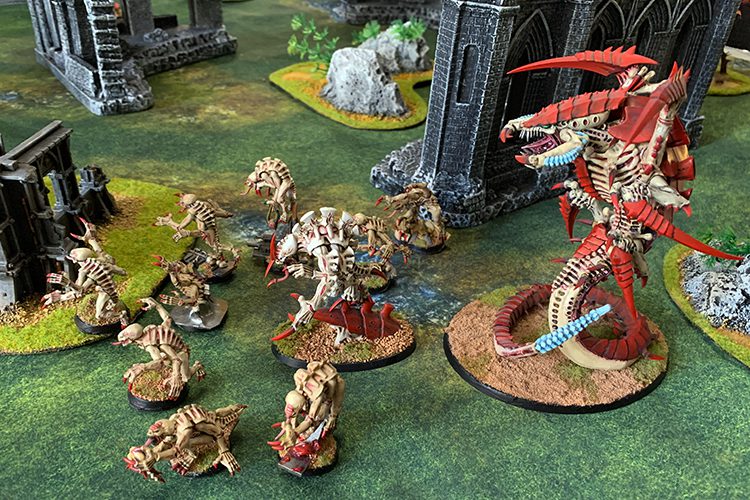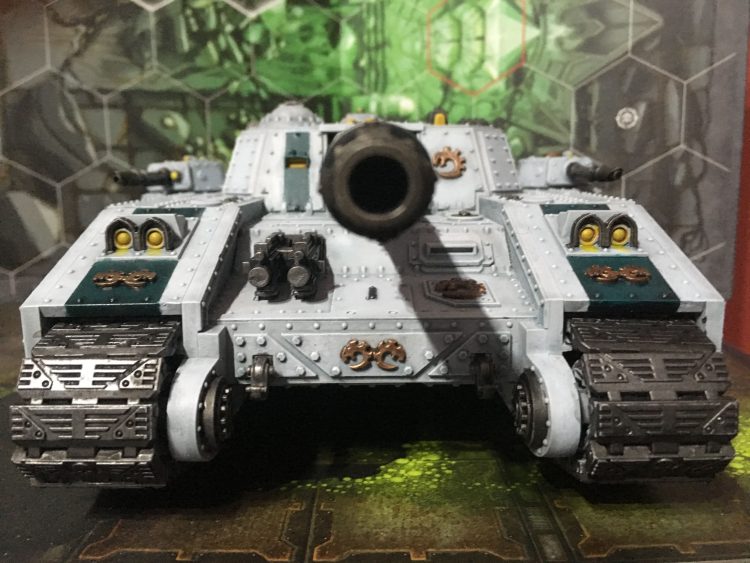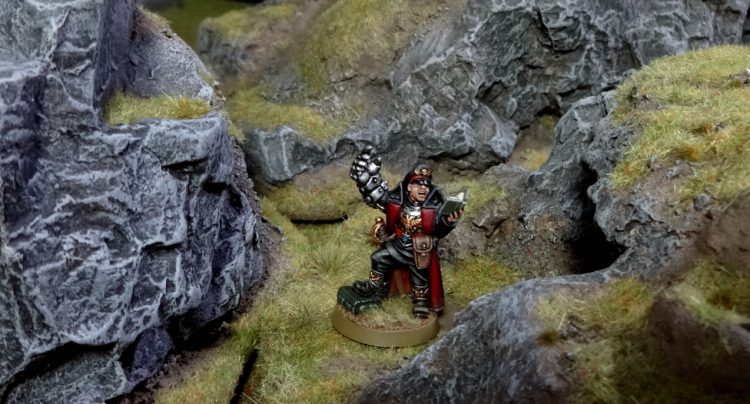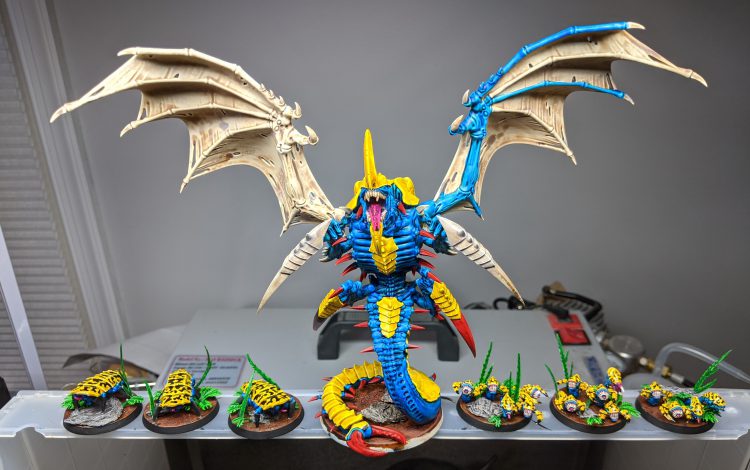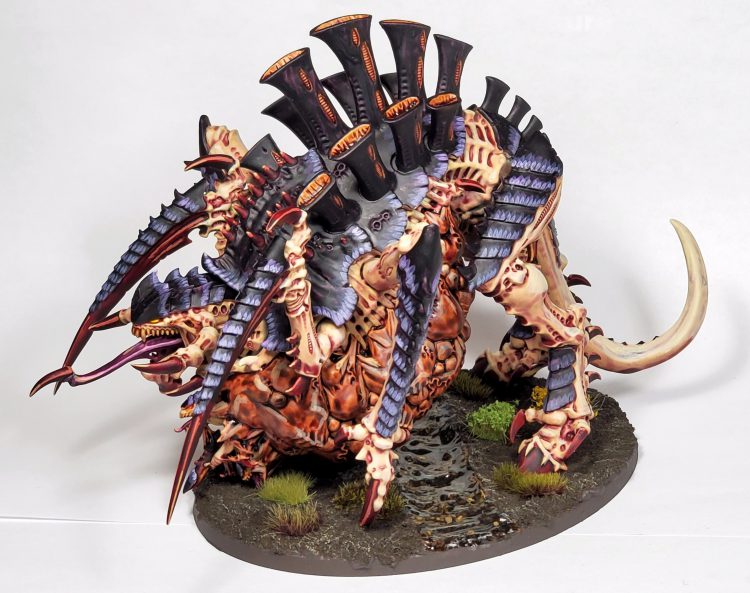Welcome back, Dear Reader, to our review of the Narrative Play rules in Warzone Octarius Book 1: Rising Tide. If you missed our review of the Matched Play rules in the book, you can find that review here. Today we’re going to be talking about the book’s Narrative play rules, which include rules for a campaign and additional crusade rules. These are in many ways linked to – but do not require – the rules from the upcoming Crusade booklet, Containment. You can find our review of that book here.
Narrative Play in Octarius
When they finally close the book on the Imperium of Man, Octarius is going to go down as one of the all-time dumbest things humans did. Inquisitor Kryptman, seeing the spreading Tyranid forces of Hive Fleet Leviathan, decided to make a desperate gamble, leading the Tyranids of Leviathan directly to the Orks of the Octarian empire. He did this, of course, by declaring Exterminatus on a bunch of planets that were in the Tyranids’ path, wiping out all life on numerous planets until the Tyranids, who had gotten pretty hungry by that point, took a left turn and found themselves smack dab in the middle of a war with the Orks.
Naturally it all worked out for the best and there were no negative consequences. Other than the multiple genocides. The End.
Touches earpiece ah nevermind I’m getting word that things were not OK and the perpetual fighting just made the Orks and Tyranids stronger and now they’re going to become best friends and come kill the Imperium. Ah, nevertheless.
As with Charadon before it, Octarius offers players rules for running campaigns. These are broken into phases, and players familiar with the rules in Charadon will be familiar with the rules listed here. The big difference between Charadon and Octarius however is that Octarius is more more preoccupied with Tree Campaign structures, offering several options for players and GMs to try out. These campaigns typically run in three stages to avoid overcomplicating the map, and the book has Victor Bonuses for players to earn, rolling a D33 against a table. In one of the smarter touches in the book, there are campaign trees for Crusade and Matched Play – each with their own missions – and if you pick up Containment, that has trees featuring Planetstrike missions.
Unlike the other campaign books, Octarius Book 1 has no missions of its own but instead has “Shadow Missions,” secret operations you can assign to one of your units to accomplish, sending them off the battlefield to take care of it while the rest of your army fights. Roll high enough and you accomplish the goal. Doing so gives you a bonus for the rest of the game, usually something that increases the cost of your opponent’s Stratagems.
On the whole, these rules are pretty interesting, and it’s good to see GW working with tree campaigns a bit more. Those are a little tougher to work with in large player groups, but you can always do a round as sides competing for a majority of wins to simplify things.

The Crusade Rules
As with the previous Campaign books set in Warzone: Charadon, units who participate in a battle using the rules in this book get a new Campaign Badge keyword: Pankallis Assault. If you’re familiar with the Warzone: Charadon books, you’ll already know how this works, but for those of you who are new to the party, picking up this keyword is a prerequisite to be able to use the Crusade options on offer here. They’ll still stay on the unit’s Crusade Card once the campaign is over, but a unit that doesn’t participate in the Pankallis Assault can’t benefit from the spoils of that particular campaign.
This is pretty straightforward, and honestly expected given previous books in this edition. And while this might get a bit out of hand down the road, being able to look at a Crusade Sheet and know roughly what sorts of options they might have available to them – or at least what book you’ll need to dive into to work that out – will be a huge help if you’re late to a Crusade and didn’t get to participate in earlier campaigns.
Pankallis Battle Traits
There are two tables here, one for Monsters and Vehicles, and one for everyone else. Each table has one trait that will help ramp up your experience, allowing the unit to gain 5XP instead of 3 each time it’s Marked for Greatness. If you badly want a particular crusade relic, this is an option, but for the most part this is probably a bit of a dud.
Your other options in the Monsters and Vehicles table mess with AP in various ways. Instrument of Destruction gives an additional -1AP to unmodified wound rolls of 6, but can’t stack with any other ability that would improve AP. Neat, but as anyone who’s played against an army with a similar rule, this can be a real pain to keep track of. The third trait, Linchpin, has a different effect depending on whether your force is part of the Attackers or Defenders alliance. If you’re an Attacker, the unit’s targets don’t get the benefits of cover to saving throws against it. If you’re a Defender, the unit ignores AP -1 when it’s attacked. Both are solid choices, and are flavorful ways of representing the asymmetry in the Planetstrike scenarios.
The traits for other units are a bit more interesting. Two of them, Planetary Invader and Planetary Defender, have similar effects but mirror each other in how they apply: each one gives units in a deployment zone the Objective Secured ability, but while Planetary Defender benefits units in your own deployment zone, Planetary Invader gives it to units in your opponent’s DZ. As a bonus, each trait gives an effect that goes off in the Charge phase, with Planetary Defenders able to declare Set to Defend or Hold Steady against any charge, while Planetary Invaders deny their charge targets the ability to fire Overwatch or Set to Defend altogether.
Also of note here is Sentinel, which has a simple but extremely powerful effect: it can shoot at units that your opponent sets up during their Reinforcements step within 12”.
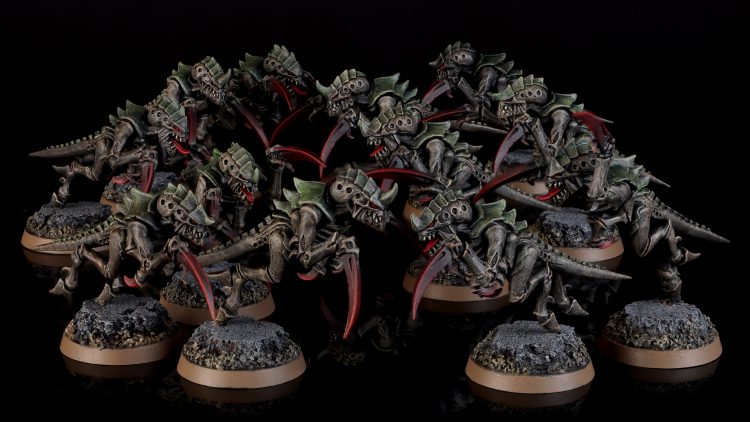
Credit: Pendulin
Pankallis Requisitions
You’ll also have some new requisitions to spend your RP on. For instance, you can wager an RP to give a second Infantry unit a Shadow Mission. It has to be different from the first one you picked, and if both units accomplish theirs, you’ll get the RP back and pick up a Planetary Assault point in the bargain. Or you could turn your force into Glory Seekers, letting you add another Campaign Agenda to chase over multiple games, potentially netting a whole pile of XP for your troubles. And if you really like taking buildings for some reason, Garrison World Strongholds lets you hang onto a destroyed building’s Fortification Upgrades on a 2+ rather than a 4+, potentially saving you a couple of RP if you lost a heavily-upgraded Fortress of Redemption or whatever.
In addition to these generally-availalbe requisitions, Imperium, Orks, and Tyranid <Hive Fleet> forces (so Genestealer Cults don’t count) each get a requisition of their own. Imperium forces get access to Inquisitorial Agenda, which lets you take an additional Agenda. Useful in basically any game, but downright incredible in the beginning stages of a Campaign when you’re only getting 1 or 2 Agendas and XP is hard to come by. Octarian Rukkboyz costs 2RP, but offers a nasty upgrade to a unit of Boyz when it’s added to your order of battle: not only does it give them 6XP out of the gate, pushing them up to Blooded and giving them a Battle Honour, it also increases their Strength to 5. This comes at a slight cost, increasing the PL of the unit by 1, and you can only do it to one unit in your Crusade force, but it’s worth it. Finally, Tyranids can use Vanguard Mind Feeder when one of their sneakier units kills an enemy Warlord, giving the unit 5XP and netting their army 2 Planetary Assault points for a mere 1RP.
All of these requisitions are at least decent, with the faction-specific ones all being downright good. Unfortunately, Chaos and non-Ork or Nid xenos players are being left out this time, which is kind of a let-down. It would have been nice to see something like they did in Charadon where there were options for armies that were neither Imperium nor Chaos, but it’s not like most players will have trouble finding stuff to spend their RP on until later in a campaign anyway.

Pankallis Campaign Agendas
In addition to the normal agendas for each game, Pankallis Assault campaigns add a new set of Campaign Agendas that see you tracking certain accomplishments over the course of the entire campaign. Once the campaign is over, you’ll check to see which of your Campaign Agendas you completed, and get a chunk of XP to distribute around your Crusade Force for your troubles.
Some of these agendas are very straightforward, like Destroyer of Worlds for Attackers and Planetary Saviour for Defenders, which give you 5 points if you were on the matching alliance and you won the Campaign. Others track your efforts in the various games, with Headhunters giving you XP if you were able to destroy the enemy Warlord at least 3 times over the course of the campaign, and Shadow War rewarding you for completing at least 3 Shadow Missions over the course of the campaign. Others key off of your actions between games, like Empire Builder, which rewards you for spending RP on the Increase Supply Limit requisition, or Forged In Battle, which gives you XP if your Crusade Points total is 10 or more.
Each player in the campaign starts with two different Campaign Agendas, though they can pick up more over the course of the campaign with the Glory Seekers requisition. They’re also not all the same difficulty to accomplish. Some, like Empire Builder, are all but impossible to fail if you lean into them. Others, like First Among Equals, which requires you to be the highest-performing player in your alliance in order to get anything out of it, are a bit more difficult. Those differences in how easy they are to achieve will sort of let you set your own personal “difficulty setting” for your campaign. Want to take it easy and see rewards at the end of the campaign? Pick some of the easier ones to accomplish and have fun. Want to up the stakes and make every game count that much more? Choose a pair of harder to complete agendas and enjoy the tension whenever your opponent surprises you with a play you weren’t expecting. This adds another lever that lets each player in your campaign subtly tweak how much they care about the results of any given game, helping players define how they want to interact with each game without completely ruining their opponent’s experience.

Fortifications Upgrades
Somewhere an Imperial Fist is crying tears of joy, as there’s finally something that might trick someone somewhere into taking a Building for them to shoot at. The pitch here is simple: Fortifications don’t gain XP and can’t get Battle Honours, so to date, there’s been even less reason to take them in Crusade games than there usually is – truly a remarkable statement. In what can only be explained as an effort to finally con Greg into running a Fortress of Redemption in the Astradus Campaign, you can now upgrade any UNALIGNED BUILDING model up to 3 times for 1RP. Each time you do that, it increases the PL of the model by 1 and gives it an upgrade.
This isn’t without risk, though: every time your upgraded building is destroyed, you have to roll a D6 for each upgrade it had. On a 4+, you lose the upgrade. You can buy it back if you want, but it costs you 1RP to do it.
Unfortunately, these upgrades are something of a mixed bag. Searchlights lets you choose an enemy unit within 24” at the start of your Shooting phase, and the chosen unit doesn’t get the benefits of cover that phase. There’s also a set of defensive upgrades, letting you choose from a 5+ invulnerable save, a 5+ to ignore wounds, or an additional 2 wounds to toughen it up a little bit. And if you’re convinced it’s going to die, you can build in an Escape Hatch, which lets the units inside use the Emergency Disembarkation stratagem to scramble out when it’s destroyed and prevents them from being destroyed in the explosion.
These upgrades aren’t likely to convince anyone to run a fortification in any game where they weren’t getting one for free, but it might be worth shoving a building in your Crusade Roster so you can upgrade it for Planetstrke games. (Ed. Note: It isn’t.)
Faction Crusade Rules
One of the biggest changes for this book – and it’s a welcome one – is the addition of Crusade rules for the supported factions. While we already had Crusade rules for Death Guard and Drukhari when the Book of Rust came out and the Mechanicus weren’t far behind, there’s not a lot of indication that we’ll see a Codex: Tyranids or Astra Militarum for some time. So if you play either army and were wondering when you’d get the ability to run a custom crusade force, your time has come.
Unlike the other rules, these aren’t limited to a Pankallis campaign.
Astra Militarum Crusade Rules
Admittedly, these rules are a little bit weird in that they still have to work with the 8th edition Codex/Psychic Awakening mash-up that constitutes the current Astra Militarum codex. That means they’re not quite as imaginative as the ones you see in the 9th edition codexes, but it also means you don’t have any weird extra points to track.
Agendas
The Astra Militarum get two agendas – Forwards, for the Emperor! rewards you with XP for putting non-aircraft units in your opponents’ deployment zones, and Inspired Command is a good way to score XP for your officers for issuing commands. The former probably isn’t worth it, offering only 1XP for each of up to 6 units in the enemy DZ, but Inspired Command is great. It gives you XP for doing what you were already planning on doing with your Officers to begin with, and lets you spread those points nicely around your army.
Requisitions
The Astra Militarum get two Requisitions as well, both of which cost 1 RP. Uplifting Primer lets you upgrade a unit when it gains a rank, giving it +1 Ld and +1 XP every time it survives a battle. Decorated Officer is for the officer corps in your army and is used to upgrade an Officer or Commissar to your order of battle, giving them 6 free XP and starting them at the Blooded rank – they get a Battle Honour immediately as well.
These are both pretty cool! Uplifting Primer really feels like a neat bonus for your vulnerable humans surviving battles and becoming hardened, and Decorated Officer is a cool way to add some veterans to your list early on.

Battle Traits
Two sets of traits, one for non-Conscript Infantry and one for non-Aircraft vehicles. The infantry table gives you six options and of these my favorite is Crazed, which lets you ignore morale modifiers and auto-pass morale once per game but the strongest is Slick Crew, which gives the unit extra hits on unmodified hit rolls of 6 when shooting Heavy weapons, which is super nasty on a Mortar squad.
For the vehicles you get three trait options and all three of these are pretty good. Tank Hunters is likely the best, giving you re-rolls of 1 to hit against Vehicle/Monster units and you automatically wound on 6s to hit if your weapon is S7 or higher and is shooting a vehicle/monster. There’s also Grizzled Crew for keeping your vehicles around longer and operating at full efficacy and Street Fighters to give your vehicles better WS and the ability to shoot heavy weapons at melee targets without incurring a penalty.
Crusade Relics
Finally we have the relics, and there are two of these. The Star of Terra gives an Officer, Commissar, or Lord Commissar a 4+ invulnerable save and +1 CP per battle. The Medal Macharia gives a senior officer the ability to issue two orders to the same unit once per Shooting phase.

Tyranids Crusade Rules
As with the Astra Militarum rules, these are straightforward and don’t have the “themed” faction-wide mechanic we’ve come to expect from Crusade rules in Codex releases. They’re more a stop-gap holdover until we get some really insane rules about eating people from every race the galaxy has to offer and using their DNA to make new and weird upgrades.
Agendas
Recover Biomass is deadly simple: if you tabled your opponent, every one of your units that survived gets 3XP. Given Tyranids’ relative power level at the moment, this isn’t one you’re likely to pick that often, but if the Leviathan supplement elsewhere in the book delivers, maybe it’s worth a look. Probably not, though.
Thankfully, your other option here is one of the coolest agendas we’ve seen so far: Tyrannoform Prey-World. When you take this agenda, you’ll be keeping a Tyrannoform Prey-world tally for each unit in your army, which increases when a unit performs the Implant Tyrranoform Seed action. In order to perform this action, you’ll need to pick an Infantry unit that’s not within 12” of an Implanted Tyrranoform Seed already at the end of your MOvement phase. Then, when the action completes at the end of your turn, the chosen unit will drop an objective marker within 1”, which is the Implanted Tyrranoform Seed. Each unit gains 2XP for every seed they implanted, and if you managed to drop one wholly in your deployment zone, one wholly in your opponent’s, and one more than 6” from either zone, you pick up 1RP as a bonus.
Condit: I am going to be 100% real here: if this agenda does not make it into the Codex, I am rioting. I love nothing more than agendas that combine interesting gameplay with strong flavor, and they’ve knocked it out of the park with this one.
Requisitions
As we’ve come to expect, the new Synaptic Link rules can’t be used on a unit when you first take it in your Crusade force. Instead, you’ll have to wait until it hits Battle-Hardened, then spend an RP on the Synaptic Link requisition to give the appropriate link. Expected, but not inspiring.
The other two are pretty cool, though. The Will of the Hive Mind lets you take an additional Agenda for 1RP, but it has to be either Recover Biomass or Tyrannoform Prey-World. So enjoy taking Tyrannoform Prey-World every game, I guess. Meanwhile, Adapt Warrior-Organisms is in the running for most useful requisition in the game, letting you choose a unit that has no Battle Scars, then swap out all of its Battle Traits for new ones. At a cost of only 1RP, this is a great option that will let you tailor a unit to fight particular foes game to game, especially with the new Battle Trait tables on the next page.
Battle Traits
The Tyranids have two sets of Battle Traits; one for Synapse (3) units and one for the non-Synapse bugs (6).
For non-Synapse Units you have some pretty fun options. Fleet of Claw has you treat Advance rolls of 1 or 2 as 3s instead and dice rolls of 1 or 2 on Charge rolls as 3s. Bio-Adapted Killers and Ravenous Strength both give your units bonuses in the Fight phase after making a charge move or a Heroic Intervention, giving you +1 Strength and +1 to hit, respectively. These are good enough that you’ll want to pull from this list instead of the Core Rules traits.
For Synapse Units the list isn’t so great; the best of them is probably Synaptic Node, which increases your Synapse range by 6” and combos with the new Synaptic Link abilities.
Crusade Relics
Tyranids have two “Relic” options, and they’re both more like extra organs than relics. The Spirit-Leech Cortex goes on a Psyker and each time they cause a wound with a psychic power they get one back and they get S+1 until the next Psychic phase, kind of turning it into a mini-Doom of Malan’Tai. The Mortrex Implant Attack is just a nasty piece of work overall, giving you +1 AP on your melee attacks, additional mortal wounds on unmodified 6s to wound, and every time you fight, if you destroy a non-vehicle enemy model you can pick a Ripper Swarm unit within 12” and add a model to them, or D3 if you killed a Monster. It’s a cool effect and the relic is already worth consideration just for the first two effects.
Final Thoughts
TheChirurgeon: Overall it’s hard to judge the Crusade rules in this book as a standalone thing; they’re clearly meant to go with the Containment Crusade Supplement we reviewed last Saturday, and after reading that it’s clear why we got new fortification datasheets in this book. We get the same Campaign rules we’ve gotten before, only now we have Predetermined Campaign Trees – a welcome addition – and optional rules for Planetstrike missions – more of a mixed bag. Once again however I feel like the Campaign rule and structure are pretty solid and worth building on, it’s just a question of whether you need those rules again. The Planetstrike rules are OK but running a full campaign off them is a bit much; they work better as the “Phase 1” missions of a campaign moreso than the whole thing.
Condit: That being said, there’s some really cool stuff in here. The Tyranids Crusade Rules in particular are a great combination of fun rules and awesome flavor, even if they haven’t gotten the full Crusade treatment yet. And I’m a huge fan of the Campaign Agendas as a way for players who might want slightly different things out of any given game to shift their play towards those goals without necessarily removing their opponent’s ability to have fun as well.
TheChirurgeon: Yeah the Tyranid Crusade rules are pretty cool. I like the Astra Militarum stuff OK but it’s more “hey those are good rules to have” than “oh that’s really cool and exciting.”
Ultimately this book is a great pickup if you’re playing Crusade and have an Astra Militarum or Tyranids army you’ve been aching to run. If you want it for a campaign, there’s some good stuff here as well, but it’s not so different from the Charadon books that if you bought those and didn’t get much use out of them this will be different. Still, a solid effort and the Crusade rules mean the book has more value to narrative players than competitive ones overall.
Have any questions or feedback? Shoot us an email at contact@goonhammer.com.
